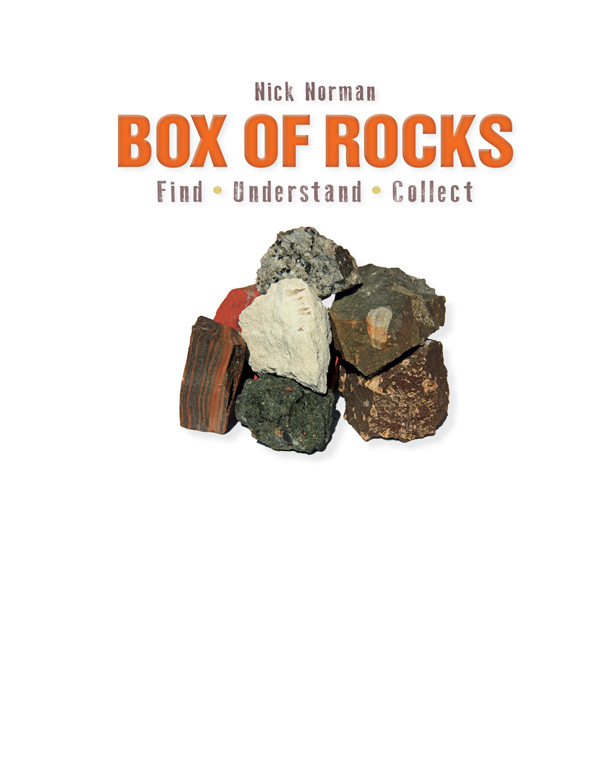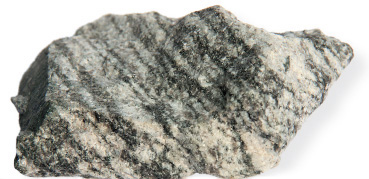












CONTENTS
INTRODUCTION
Have you ever picked up an eye-catching stone or rock and wondered how it formed? This book will answer some of the questions you may have about rocks. Youll learn about 12 common rock types found in South Africa, many of which you have probably seen or even collected. They are all easy to find, although some may not occur close to where you live. But before we hunt for rocks, lets find out what rocks are made of.
What is a rock made of?
Rocks are made up of grains of various minerals that are packed tightly together. So you can think of minerals as the building blocks of rocks. There are many different sizes, shapes and colours of minerals. Quartz is a good example of a rock-forming mineral. The crystals that make up a mineral can be very tiny and even microscopic, if they formed quickly, or big if they formed slowly, allowing them enough time to grow.

This rock has some big crystals set in a mass of much finer crystals.
Below the earths surface
If you could cut a section out of the earth youd see that it has four main layers. We live on the very thin top layer, called the crust.

Our restless earth
As you sit reading this, you are moving and your house is moving; in fact, everything on earth is moving! Usually this movement is as slow as the growth of your fingernails you cant watch it, but its definitely happening. Lets look at how the earth moves.
The rigid outer crust of the earth is made up of big rocky sections called tectonic plates.
The partly melted mantle underneath these plates flows very, very slowly. Because the solid rocky plates float on the mantle, they can tear apart or squash together as the mantle slowly churns. One place where the plates of the earths crust are slowly pulling apart, leaving a huge gap or valley, is in the Rift Valley in East and Central Africa.

All the land and all the oceans on the earths crust are in sections, floating on the earths partly melted mantle. These jigsaw-like pieces, which fit tightly together, are called tectonic plates.

Valleys form where tectonic plates move apart.
Mountain-building
While tectonic plates in some places are moving away from each other leaving valleys, tectonic plates elsewhere on earth are crashing together and making mountains. Where this happens one of the plates moves down and under its neighbour, forcing the other plate upwards, in a process we call uplift. Wherever this happens, earthquakes and volcanoes are common.
The Ring of Fire is an area around the Pacific Ocean where lots of earthquakes and volcanoes occur. Thats because tectonic plates are colliding here. Another example is India, which is on its own tectonic plate and is slowly crashing into the continent of Asia. This has forced up the mightiest mountain range on earth, the Himalayas.
Very far in the future, East Africa will break away from the rest of Africa along the Rift Valley and slowly ram into Asia, making another giant mountain range.

iStock.com/luxcreative
Colliding tectonic plates have forced up the mighty Himalayas.
TYPES OF ROCK
There are three main groups of rock on earth igneous, sedimentary and metamorphic rocks. Each group was formed in a different way from the other groups. Lets find out a bit more about how the different groups of rock form.
Igneous rocks
Igneous rock is the name given to all rocks that harden from liquid magma. Volcanoes often occur where tectonic plates collide and one of the plates gets pushed under the other, deeper and deeper underground. The weight of all the heavy rock layers above pushes down hard on the lower layer and, at the same time, the rocky plate gets hotter and hotter the deeper it goes. Eventually the rocks start to melt, forming magma.
If a crack opens up in the earths crust above it, the magma will quickly escape to the surface where it is cooler and there is much less pressure. Once it emerges (extrudes) onto the surface of the earth, we refer to magma as lava. As the lava cools, it hardens to form igneous rock. Magma can also squeeze (intrude) into and between the upper layers of rock, so it cools and hardens more slowly beneath the earths surface.

When tectonic plates collide, one plate gets pushed under the other, causing the rocks to melt.

(c) Westend61/Photoshot
Volcanoes often occur where tectonic plates collide.

Rocks that float
Some lava comes to the surface with a huge amount of gas in it. It shoots out of its volcano like a fizzy drink out of a bottle thats been shaken up. And it chills in the air with all that gas trapped inside it, so its light like polystyrene. This lava is called pumice and it floats. If you look carefully you may be lucky enough to find pumice on the beach at Arniston. These are the remains of lava blasted out of Krakatoa in Indonesia, which erupted in 1883. Pumice floated right across the Indian Ocean and washed up on our shores!

































